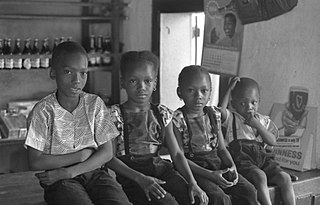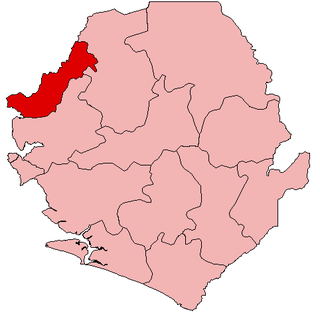The demographics of Sierra Leone are made up of an indigenous population from 18 ethnic groups. The Temne in the north and the Mende in the South are the largest. About 60,000 are Krio, the descendants of freed slaves who returned to Sierra Leone from Great Britain, North America and slave ships captured on the high seas. In addition, about 5,000 Lebanese, 1,000 Indians, and 5,000 Europeans reside in the country.

Kabala is the capital and largest town of Koinadugu District in the Northern Province of Sierra Leone. Kabala is one of the main towns in Northern Sierra Leone and is set in a rural landscape, surrounded by mountains.

The Limba people are the third largest ethnic group in Sierra Leone. They represent over 8% of Sierra Leone's total population.

The Temne people, also called Time, Temen, Timni or Timmanee people, are a West African ethnic group. They are predominantly found in the Northern Province of Sierra Leone, as well as the national capital Freetown. Some Temne are also found in Guinea. The Temne constitute the largest ethnic group in Sierra Leone, at 35% of the total population, which is slightly more than the Mende people at 31%. They speak Temne, a Mel branch of the Niger–Congo languages.

Kambia District is a district in the Northern Province of Sierra Leone. Its capital and largest city is the town of Kambia. As of the 2015 census, The District had a population of 343,686. Kambia District borders the Republic of Guinea to the north, Port Loko District to the south and Bombali District to the east. The district provides an important Trade route to or from the Sierra Leonean capital Freetown to the Guinean capital Conakry.

Kambia also commonly known as Kambia Town is the capital and largest town of Kambia District in the Northern Province of Sierra Leone. Kambia is a major trading town; and lies approximately 120 miles north-east of Freetown. The town had a population of 11,842 in the 2004 census, with a 2010 estimate being 12,471 and a current estimate of 40,000. Kambia is a major trading route along the main highway linking Sierra Leone's capital Freetown to Conakry, the capital of Guinea.

The Susu people, also called Soso or Soussou, are a West African ethnic group, one of the Mandé peoples living primarily in Guinea and Northwestern Sierra Leone, particularly in Kambia District. Influential in Guinea, smaller communities of Susu people are also found in the neighboring Guinea-Bissau, Senegal and Mali.

The Loko are one of the indigenous ethnic groups in Sierra Leone. Landogo is used as an endonym for the people and language, but other groups refer to them as Loko. They speak a Southwestern Mande language that is also called Loko. The majority of the Loko people live in the Northern Province of the country, particularly in Bombali and Port Loko District, and around the capital city of Freetown in communities such as Regent. Important regional towns include Tambiama, Kalangba, and Gbendembu, though other groups such as the Mandingo, Fula and Temne peoples live there too.

Gbinti is a rural town in Dibia chiefdom, Port Loko District in the Northern Province of Sierra Leone. The town is the chieftaincy seat of Dibia chiefdom. Gbinti lies about 20 miles from the district capital Port Loko and approximately 52 miles from Freetown.

Kamabai is a small town in Bombali District in the Northern Province of Sierra Leone, with a population of about 4000 within a 7-kilometre (4.3 mi) radius. The town is about 41 kilometres (25 mi) northeast of Makeni. The town has several secondary schools, including the Kamabai secondary school, which is one of the largest secondary schools in Northern Sierra Leone, a government hospital and a nightclub.
Kalangba (/kælæŋbæ/)(Loko: Ngangba) is a rural village in Bombali District, Northern Province, Sierra Leone. It is the headquarters for Gbendembu Ngowahun Chiefdom. It is situated about 15 miles northwest of Makeni, the largest city in Sierra Leone's northern region. Kalangba is approximately 82 miles north-east of the nation's capital, Freetown. It is a multicultural community. The majority of the inhabitants belong to the Loko ethnic group as well as the Fula and Mandingo. The Loko are the fifth largest ethnic group in Sierra Leone. As of the 2016 census, the population was 3,000.

Sierra Leone is officially a secular state, although Islam and Christianity are the two main and dominant religions in the country. The constitution of Sierra Leone provides for freedom of religion and the Sierra Leone Government generally protects it. The Sierra Leone Government is constitutionally forbidden from establishing a state religion, though Muslim and Christian prayers are usually held in the country at the beginning of major political occasions, including presidential inauguration.
Sierra Leone is a multilingual country. English is the de facto official language, and Krio is the most widely spoken.

Tissana is a coastal village near the city of Waterloo in the Western Area Rural District of Sierra Leone. Tissana village is located close to the neighborhood village of Russell along the Freetown-Waterloo highway. The major economic activities in Tissana are the processing of salt, palm oil, and tourism.

Sierra Leone is home to about sixteen ethnic groups, each with its own language. In Sierra Leone, membership of an ethnic group often overlaps with a shared religious identity.












